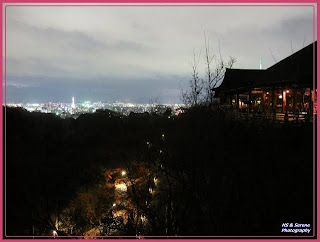 Location: 1-294 Kiyomizu Higashiyama-ku, Kyoto
Location: 1-294 Kiyomizu Higashiyama-ku, KyotoTel: 075-551-1234
How to get there: 10-minute walk from City Bus Stop Gojozaka (from Keihan Shichijo Station and JR Kyoto Station) / 10-minute walk from City Bus Stop Kiyomizu-michi (from Keihan Shijo Station/Hankyu Kawaramachi Station) / 25-minute walk from Keihan Gojo Station / 10-minute walk from City Bus Stop Higashiyama-gojo
 We reached here rather late, as I would say. It was about 4pm and the day start getting dark, due to the winter season. After visiting all the temples around Kyoto city, this is the last temple that we were visiting for the day.
We reached here rather late, as I would say. It was about 4pm and the day start getting dark, due to the winter season. After visiting all the temples around Kyoto city, this is the last temple that we were visiting for the day.There are many stalls on the way leading up to the temple. We did stop by and have a look on the uniqueness of the souvenirs.
 The deva gate is waiting her visitors everyday. It is a very nice place to take photo, however we were running out of time as it is quite dark at that moment. We still need to rush our journey to the top of the hill where the main hall of the temple is located.
The deva gate is waiting her visitors everyday. It is a very nice place to take photo, however we were running out of time as it is quite dark at that moment. We still need to rush our journey to the top of the hill where the main hall of the temple is located. From main hall, there is a veranda supported by a tall pillar where everyone can have an impressive view of the city, especially at night. Further down, one may get a nice place to have a shot of the temple together with the city view. It would better during the sunset. From the research done, the best time to have a great view is during the cherry blossoms period (late March to early April). You may refer to the forecast at http://gojapan.about.com/od/cherryblossom/a/sakuraforecast.htm
From main hall, there is a veranda supported by a tall pillar where everyone can have an impressive view of the city, especially at night. Further down, one may get a nice place to have a shot of the temple together with the city view. It would better during the sunset. From the research done, the best time to have a great view is during the cherry blossoms period (late March to early April). You may refer to the forecast at http://gojapan.about.com/od/cherryblossom/a/sakuraforecast.htm Kiyomizu-dera was founded in the early Heian period. The temple dates back to 798, and its present buildings were constructed in 1633, during a restoration ordered by the Tokugawa Iemitsu. Not one nail is used in the whole temple. It takes its name from the waterfall within the complex, which runs off the nearby hills. Kiyomizu means clear water, or pure water.
Kiyomizu-dera was founded in the early Heian period. The temple dates back to 798, and its present buildings were constructed in 1633, during a restoration ordered by the Tokugawa Iemitsu. Not one nail is used in the whole temple. It takes its name from the waterfall within the complex, which runs off the nearby hills. Kiyomizu means clear water, or pure water.It was originally affiliated with the old and influential Hossō sect dating from Nara times. However, in 1965 it severed that affiliation, and its present custodians call themselves members of the "Kitahossō" sect.
 The main hall of Kiyomizu-dera is notable for its vast veranda, supported by hundreds of pillars, which juts out over the hillside and offers impressive views of the Kyoto city. The expression "to jump off the stage at Kiyomizu" (「清水の舞台から飛び降りる」) is the Japanese equivalent of the English expression "to take the plunge". This refers to an Edo period tradition that held that, if one were to survive jumping from the stage, one's wish would be granted.
The main hall of Kiyomizu-dera is notable for its vast veranda, supported by hundreds of pillars, which juts out over the hillside and offers impressive views of the Kyoto city. The expression "to jump off the stage at Kiyomizu" (「清水の舞台から飛び降りる」) is the Japanese equivalent of the English expression "to take the plunge". This refers to an Edo period tradition that held that, if one were to survive jumping from the stage, one's wish would be granted.This appears plausible: the lush vegetation below the platform might cushion the fall of a lucky pilgrim, though the practice is now prohibited. 234 jumps were recorded in Edo period and of those, 85.4 percent survived. The fall is indeed only 13 metres, which remains impressive for a wooden construction.
Beneath the main hall is the Otowa waterfall, where three channels of water fall into a pond. One can catch and drink the waters, which is believed to have therapeutic properties. Drinking the water of the three streams is said to confer wisdom, health, and longevity. However, some Japanese believe that you must choose only two; if you are greedy and drink from all three, you invite misfortune upon yourself.
For more information of the temple, you may visit their official website: http://www.kiyomizudera.or.jp/.
No comments:
Post a Comment